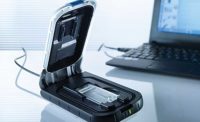Food-borne illness is no laughing matter. In 1985, a listeriosis outbreak in Southern California killed as many as 40 people. The outbreak was eventually traced to a Mexican-style soft cheese contaminated with the bacterium Listeria monocytogenes.
To prevent such outbreaks, food and drug manufacturers take great pains to test their products frequently for any sign of contamination. The equipment they use must meet rigorous requirements set forth by the Association of Analytical Communities International (AOAC), a nonprofit organization that develops standards for laboratory devices.
In 2012, test equipment manufacturer Invisible Sentinel was ready to begin manufacturing its Veriflow testing device after nearly six years of research and development. The handheld device detects food-borne pathogen signatures at the molecular level, eliminating the need for food processors to use expensive equipment and time-consuming lab tests to detect these pathogens.
Invisible Sentinel faced a major challenge, however. It needed to make sure that both halves of the device’s high-impact polystyrene housing were joined to form an airtight seal and ensure 100 percent protection against contamination, as required by the AOAC.
The housing had to withstand significant pressure created by the device’s internal processes. At the same time, assembling the housing could not damage any interior test mechanisms, which are delicate and have varying melt indexes.
Eventually, Invisible Sentinel met with Branson Ultrasonics Corp. to discuss the feasibility and benefits of ultrasonically welding the housing. Branson recommended its 2000X-d assembly system for the task.
Through controlled experiments, engineers from both companies determined the optimum force, triggers and distance settings to maximize system energy and efficiency in the welding process. Separately, Branson engineers defined the horn and nest parameters using finite element analysis.
In operation, the system maintains optimum melt-collapse distances to ensure repeatable welds within a 0.001- to 0.002-inch tolerance. It also features an S-beam load cell and optical linear encoder that provide accurate feedback and control.
Equally important, the system monitors internal variations to prevent any damage to interior test mechanisms. Invisible Sentinel operators change process parameters or control limits via a touch screen as needed.
In early 2013, AOAC certified the Veriflow device to detect both Campylobacter and L. monocytogenes. This year, AOAC certified the device to detect both the Listeria species and Salmonella.
Invisible Sentinel currently manufactures more than 1,000 units daily. But, the company anticipates eight-fold growth in the near term to serve an expanding global demand.
For more information on ultrasonic welding, call 203-796-0400 or visit www.bransonultrasonics.com.








